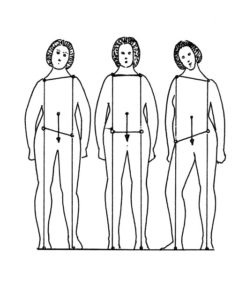

Scoliosis is defined as a spinal curvature which strays from the symmetrical axis, so that the spine curves to the right or to the left in the Plana frontalia, while in most cases, this curvature is also accompanied by a rotation of the vertebra. The Scoliosis condition may manifest one or more curvatures with varying degrees of deviation, with each placed on a different point of the spine. It is commonly referred to as a C or an S shape.
As opposed to other conditions which the physical system may confront, Scoliosis is not an episodic condition which one might expect will improve in time, rather a physical deformity requiring treatment intervention from a health perspective as well as from an aesthetic perspective.
A medical orthopedic treatment is offered only when the curve deviates 20° from the axis. In such a case, the prevalent treatment is the use of spine braces for a prolonged period of time. A surgical intervention will take place should the spine braces fail to restrain the curvature and the curve has reached approximately 40°. We will specify our position regarding each treatment.
In most cases, the “Body Cognition” method separately opposes both of these treatments: a spinal brace treatment and surgical treatment.

You Can Straighten Up
Debora Zilberstein
“Ma’ariv”, Israel 5.6.1998
Yosepha Michaeli – “On Symmetry and Asymmetry -Scoliosis”
Body Cognition, independent publishing
“Body Cognition” is a method developed by Yosepha Michaeli (a physiotherapist) for treating the body and its posture. Even though hundreds of people all over the country are practicing her method twice a week and despite the fact that she has been active for decades (40!), the method still lacks publicity.
A possible explanation for this may be that a lesson in the Body Cognition method is a person’s in-depth encounter with his/her body on the mat. Or, maybe, it is because the encounter takes place in the clandestine fabric of creation, where the body communicates with the brain and with the senses and emotions in a unique language which repeats itself and at the same time renews itself in every meeting. The last thing you feel like doing after a meeting is to go and tell your friends about it.
If Yosepha Michaeli had not published a book summing up her doctrine of the Body Cognition regarding the treatment of Scoliosis, and if she had not presented here her reservations regarding the conventional method of treating the problem, I would not venture to expose the method publicly today.
The Orthopedic institution, though it had witnessed many cases which benefited from the blessed results of the Body Cognition therapy in the very boys and girls for which it claimed: “Only surgery!” or: “the girl must wear a back brace night and day for two years!”, did not bother to inquire about the Body Cognition method even though the method is not some esoteric alternative and is based on conventional anatomical and orthopedic principles. Michaeli describes in detail the irreversible damage in the body of those suffering from Scoliosis and of their self image, which are caused by the wearing of the back brace, within the accepted terms and premise in the orthopedic discussion. It is hard to comprehend why the orthopedic community does not inform their patients of an alternative treatment method, which has certified photographs of success stories following the posture of persons with Scoliosis throughout the entire process, including X-rays.
The orthopedic institute looks only at skeletal aspect of Scoliosis, therefore, literally “attacking” the skeleton while aiming to treat the disease. In her book, Michaeli claims that the problem is complicated and more complex than that: the skeletal asymmetry is maintained and always exacerbated by a cognitive aspect as well: the brain, responsible for the symmetric organization of the body, “errs” in reading the center of the back. She claims it is possible and recommended to include the element causing the problem in order to resolve it.
The Body Cognition method is designed to treat persons suffering with Scoliosis through movement creating stimuli in the central nervous system which enables the brain to correct the mistake in which it was firmly fixed. Most cases involve young boys and girls, with a skeleton that is still flexible. After understanding and practicing listening to the body, the muscles then can, through a “directed and correct” order from the brain, straighten the skeleton with as much success as when a brace or a rod fixate the spine.
The person afflicted with Scoliosis who is ready to undertake the responsibility of the correctional process to fix his/her Scoliosis and learn to reach his/her correct center (in the meetings open to the public) – find optimal symmetry in the varied positions – will gain, besides a healthy, flexible and aesthetic posture, also the reported joy Body Cognition students derive from the meetings.
The book is first and foremost intended for boys and girls suffering from Scoliosis and their parents. Also, the book is recommended to physical education teachers, physiotherapists, doctors and orthopedics, who are open to a professional, serious and specified approach and are willing to learn from its successes.
